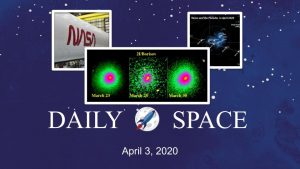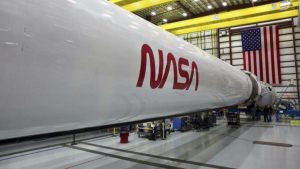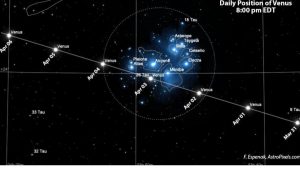
A bored astrophysicist makes a mistake with magnets while inventing a coronavirus device, the NASA “Worm” logo returns amid fanfare, Comet Borisov splits in two, and the Pleiades embrace Venus for some excellent viewing.
Links
Astrophysicist makes mistake inventing device
Return of NASA “Worm” logo
Comet Borisov breaks
- Interstellar Comet 2I/Borisov Really Is Breaking Apart, According to New Data (Science Alert)
- Interstellar Object 2I/Borisov Double (Astronomer’s Telegram)
It’s time to view the Pleiades
- The Pleiades embrace Venus (Sky and Telescope)
- Venus and the Pleiades in April (NASA)
Transcript
This is the Daily Space for today, Friday, April 3, 2020.
Welcome to the Daily Space, I am your host, Dr Pamela Gay, and I am here to put science in your brain. Most Mondays through Fridays either I or my co-host Annie Wilson will be here, bringing you a quick run down of all that is new in space and astronomy.
As we move into the weekend, this episode of the Daily Space is going to focus on things that hopefully can amuse you away from the weirdness of the day to day world around us. As science productivity slows, we’re find astronomers applying their intellectual and emotional energy in the weirdest of ways.
Once upon a time, procrastination meant cleaning your desk, but apparently everyone’s desks are now not only clean, but polished, and maybe even bleached. Seeking new forms of distraction, many scientists have turned their statistical skills toward modelling how the coronavirus may or may not be moving through populations, and trying to understand if we can work backwards to figure out how many undetected cases must be out there to explain what we’re seeing in our hospitals. Astronomers, who are used to only seeing the brightest stars in distant systems, have the numerical modelling skills to do this kind of work, and are in general confirming the results coming out of epidemiologists labs. This work is solid, helps us get extra eyes looking for holes in how we’re thinking about things, and more importantly, does no harm. Where astronomers and physicists really need to stop getting involved is in the medical devices area of research.
In a now famous case, Australian researcher Daniel Reardon used his downtime to try and construct something to stop him from touching his face. Like many of us, he had random electronics and magnets laying around. While I have fantasies of building things that light up or move in response to Twitch chat, his dream was apparently to build something that would buzz when he brought his hand too close to his face, and he created a circuit that could be worn as a necklace, and he thought he designed it with components that would buzz if a magnetic came near. No. This is not what he had on hand. What he had was something that would buzz if the magnet got too far away – this is the kind of sensor that gets shouty when a fridge door is opened or something. When he slipped on the necklace and the magnetic bracelet he’d also made with super strong natural magnets, he discovered he had a system that would buzz if he took his hand away from his face. No bueno. Still bored, and still surrounded by cool things like magnets, he decided to first use pairs of magnets to make fake earrings. I have to admit, I two have done this. It kind of hurts. Then, still apparently bored, he made fake nose studs… with magnets… but putting a magnet inside and outside each nostril. This is where mistakes were really made. If you, like him, decide to make magnetic nose jewelry, you need to remove them one side at a time, but removing what is in your nose and out of your nose together. This is not what he did. He removed the two outside-the-nose magnets, causing the two inside the nose magnets to crash together inside his nose where they did not want to release his nose or one another. Various attempts were made to get them out, all of which failed because, well the middle part of your nose has a small bulge of cartilage. Eventually, a hospital was required, and now… we can laugh at the fact that a PhD does not confer common sense.
You can’t make this shit up people. You can’t make this up.
So, scientists out there who want to help, I’m here to remind you, you can help by staying inside, washing your hands a lot, and overtipping the nice person who brings you things from instacart. You can even run some computer models. Just… don’t get into the medical device arena unless you’re 3D printing things specifically requested, or sewing masks. Be Emily Lakdawalla, folks, that’s the role model to follow.

CREDIT: NASA
Moving on…
In news I had to triple check wasn’t an April fools joke, NASA has announced they are bringing back the classic NASA worm logo from the 1970s. Throughout my life, we’ve been told it was strictly forbidden to use this logo as it was retired. But… we all coveted this logo and its swoopy simplicity. Now, as my generation rises up in NASA, someone mysterious soul has won us the ability to finally and officially use this logo again. I want to buy this person a drink. Officially, it’s coming back to celebrate the return of manned space flight using US made rockets. The old limitations are also being removed. While NASA style guides dating back to the days of the original worm logo usage required it to only appear horizontally, it will clearly be rotated into the vertical when this falcon 9 is stood up to take flight.

Switching topics entirely, we have word from David Jewitt, Max Mutchler and company that the Interstellar Comet, 2I/Borisov has split into two separate pieces . This occurred on or about March 28, when the system puffed out dust and debris. This kind of a breaking up isn’t hard to do for comets, and is quite common. The HST is now able to see a double core, and this team will continue monitoring this double core’d comet to see if the pieces appear to drift apart. This means that this icy blob formed in a distant solar system, traveled for perhaps 10s or 100s of light years or more, and as it passed through our solar system was put under attack by our Sun’s light, heat, and gravity. This is clearly meant as a warning to all other interstellar objects – don’t mess with the solar system – we can mess you up!

This digital sky map illustrates the path of the inner planet as the beautiful conjunction evolves, showing its position on the sky over the next few days. The field of view shown is appropriate for binocular equipped skygazers but the star cluster and planet are easily seen with the naked-eye. CREDIT & Copyright: Fred Espenak (Bifrost Astronomical Observatory)
In one final note of the day, if you happen to have dark skies after sunset tonight, you need to get out and look up and toward the west. The brightest thing you see will be the planet Venus, and if you have dark skies you will be able to make out a cluster of stars – the pleiades – that Venus is just brushing up against. This kind of an alignment happens every 8 years and is just pretty to look at, so if you can, step out on your patio, driveway or yard and catch something nice in the sky.
And that rounds out our show for the day.
<———————>
As part of helping keep us all occupied in these really weird times, we’re going to be hosting a lot of additional content on our Twitch channel, and we want to remind you that CosmoQuest has an active community on Discord where you can talk science and even find other people to join you in playing some online games. You can find links to everything that is going on at CosmoQuest.org.
Thank you all for listening. Today’s script was written by Pamela Gay, and the Daily Space is produced by Susie Murph. The Daily Space is a product of the Planetary Science Institute, a 501(c)3 non profit dedicated to exploring our Solar System and beyond. We are here thanks to the generous contributions of people like you. The best way you can support us is through Patreon.com/cosmoquestx Like us? Please share us! You never know whose life you can change by adding a daily dose of science.


 We record most shows live, on Twitch. Follow us today to get alerts when we go live.
We record most shows live, on Twitch. Follow us today to get alerts when we go live.